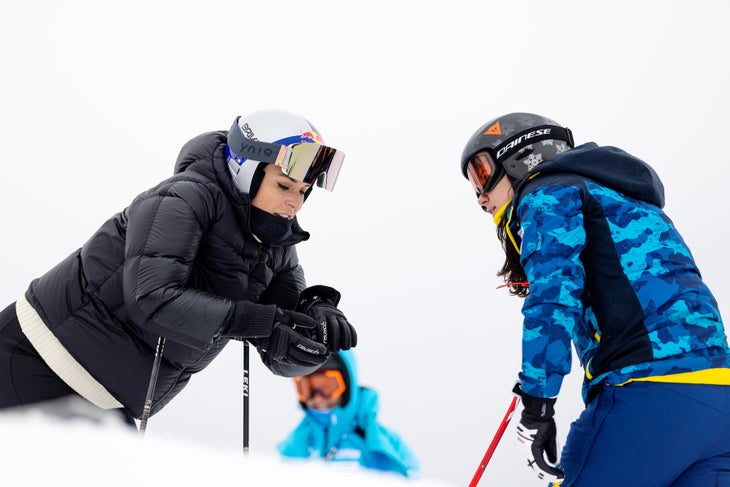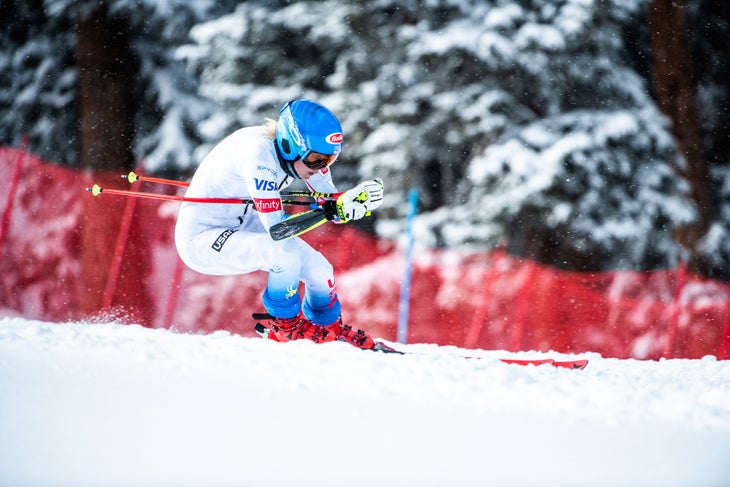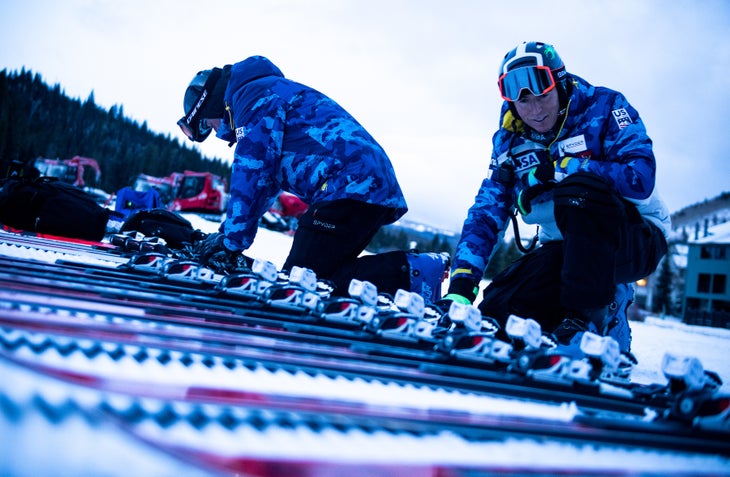Products You May Like
Tune into SKI’s Olympics homepage to stay up to date on all the stories and latest news from Beijing.
Speed skiers, the racers who compete in the downhill and super-G events, are a different breed. Routinely throwing oneself down icy, bumpy tracks at speeds in excess of 80 mph, where the slightest mistake or misjudgment can mean disaster, may sound a little crazy. Ok, maybe a lot crazy. But to be successful in these most dangerous of the alpine events takes more than just sheer guts.
Conventional wisdom says that it takes years to gain the experience needed to rise to the top of the pile in the downhill circuit. “I feel like that’s a bit of a myth,” says four time Olympian Marco Sullivan who cites many athletes, including himself, who have had their best results their first time on a course. “If you’re really confident, and the hill suits you and you’re ready to take that aggressive mindset, you can do it.”

Neither rookies nor seasoned vets will have seen the 2022 Olympic speed courses at the Yanqing National Alpine Skiing Centre before arriving in Beijing. Two-time Olympian Laurenne Ross points out, however, that veterans may still have an edge at adjusting to this brand new hill’s particular challenges. “They have so much experience in so many different conditions that they are better at adapting,” says Ross.
Experience or not, here are just a few things the athletes will be looking to dial in by race day in order to give themselves an edge over their competitors.
Related: Here’s why the Beijing Games will be different than any other Winter Olympics
Course Inspection
This is when racers slide down the course and pick their line, assessing not only the course set, but, even more-so, the terrain. As Daron Rahlves explains in the American Downhiller podcast, “in Downhill you are skiing the mountain, not the course.” With no previous experience to gauge the mountain’s terrain, and no natural features—like trees whizzing by—to gauge speed, it was not surprising that many top athletes—including four of the top five finishers—missed gates in the first downhill training run on Feb. 3.
Inspection is especially critical in super-G, where the speeds are nearly as high, the corners are sharper and often blind, and there are no training runs before the race. Unlike in downhill, nobody knows how a super-G course will run until the first racer goes. It is not unusual to see early racers come over terrain and completely miss a gate because they misjudged their speed or line.
Line Choice
Training runs are where athletes experiment with line, figuring out where on the course they can open the throttle and where they need to take a more conservative approach. As Sullivan points out, the most important turns in any course are the ones that bring your momentum off the steeps. “That transition from steep to flat is the most important part of any course. Those are the turns you really have to focus on.”

By race day, when the big air and tough turns have been identified, most athletes will be on a similar line through the course. Some racers, if they feel comfortable enough on the course, will “push the line” on race day, taking a riskier, more direct path to gain extra speed. When that works, it shaves time. When it doesn’t, it can mean a missed gate—or worse, a crash.
Gliding and Aerodynamics
“Good gliders” are racers who are able to let their skis “swim” on the flats, using a minimal amount of edge pressure to turn, and thereby creating the least friction. The Beijing course features flat sections at the top and bottom, where racers can “grab the bully” and drop into a low, bullet-like tuck. To find their ideal tucks, athletes spend time in wind tunnels, where they can tweak their various tuck positions to find a position with the least amount of drag.

Even more important than an ideal low tuck, however, is staying as aerodynamic as possible while coming out of the tuck to make turns and absorb bumps. At downhill speeds, any body part that comes out of line will act like a sail, not only creating drag, but also affecting balance. The fastest racers are those who can execute clean turns while staying as compact as possible, on the ground and in the air.
Air Time
It’s always faster to be on the ground than in the air, so athletes who absorb terrain have an advantage. At this year’s men’s World Cup downhill in Val Gardena, for instance, winner Bryce Bennett used his long limbs to absorb the many big bumps on the track to keep his skis on the ground. Big air, however, also indicates big speed, so it can be a good thing. The key to taking “good air” is keeping a compact body position, with hands down and close to the boots, and air flowing over the skis rather than under them.
Athletes want to avoid the dreaded “starfish” position, where the body fully opens up, catching air and throwing them off balance. Other common mistakes are athletes taking off with their weight too far back, causing the tips to go up and increase drag, or taking off with a “loaded” ski (one that is turning) rather than a flat ski. This move, seen by several athletes off the “Saddle” jump in Beijing, can lead to especially dangerous flights.
Skis
No matter how good an athlete’s line, aerodynamics and gliding ability, it takes fast skis to win in downhill and super-G. This is especially important on a course like the one in Beijing, which has long gliding sections on extremely cold and dry, entirely man-made snow. In ski parlance such snow is called “aggressive,” and it grabs at the skis rather than letting them slide.
Related: The Beijing Olympics will be the first to use almost 100 percent man-made snow
How fast a ski glides in certain conditions depends on the base material, the machine grind put into the base at the factory, and the wax applied to the ski, both on race day and over time. Here again, this untested venue presents challenges for the ski techs, all of whom are scrambling to find the magic combination of base material, grind, and wax for their athletes, with no historical data. They will choose from a quiver of skis that are their best guess based on the limited information they have. “I think the ski choice will be a big deal,” says Sullivan. A ski that runs well in Lake Louise could do well in Beijing.”
Tweaks and Tuning
The snow also presents another challenge, and possibly an advantage for the Americans. This type of aggressive snow—which is far more similar to early-season, man-made Colorado snow than to warmer, wetter European snow—can be tricky for athletes, often requiring adjustments to their technique and equipment.

“It’s more difficult when the snow is really aggressive to nail the equipment,” Ross explains. “You start getting catchy and your skis hook up really fast. It can be sketchy.” This often requires athletes to tweak their boots, bindings, and skis to achieve a comfortable balance of precision and forgiveness in their equipment. Ross points out that this might favor the Americans, who train on aggressive Colorado snow during the early season, as well as any athletes who are used to making those types of adjustments.
Read more: Who makes the fastest skiers in the world even faster? The technicians behind the scenes
The Luck of the Draw
On the Beijing course, where the sun is always out and the surface is uniformly bulletproof, changing conditions and any specific bib number will play less of a role than the gusty and unpredictable winds on all parts for the course. Those were already a factor in training runs—the third men’s training run was cancelled due to high winds—and likely will be on race day as well.
However, as challenging as it is for athletes and their teams to tackle an untested slope, both Ross and Sullivan are positive about a brand new venue, both for spectators and athletes. “In my opinion, the course being raced sight unseen is kind of cool,” says Sullivan. “I feel like it really favors the skiers who are strong and skiing well at the moment, as well as the younger skiers, who don’t necessarily know their main strengths yet.” Ross concurs that a new venue can be a positive thing, noting, “It kind of levels out the playing field.”
Regardless of experience, training run results and predictions, the Olympics are wide open in the speed skiing events. “It’s anybody’s game,” says Ross. “Once you step into the start gate, you just have to give it everything you have, because it is the biggest race of your life.”
The Beijing Olympic speed skiing events kick off on Feb. 5 at 10 p.m. EST. Here’s how to watch Americans Bryce Bennett, Ryan Cochran-Siegle, and Travis Ganong go for gold on NBC and its affiliate programs.
